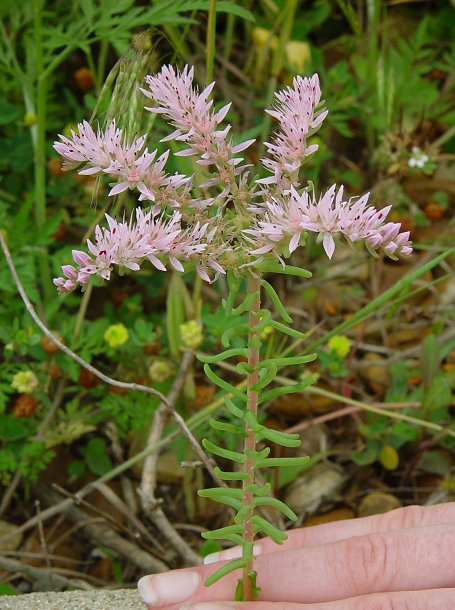Sedum pulchellum Michx.
Widow's Cross

Native
CC = 7
CW = 3
MOC = 35
© DETenaglia
Sedum pulchellum Michx.Widow's Cross | |
 |
Native CC = 7 CW = 3 MOC = 35 |
© DETenaglia |
|
Family - Crassulaceae Habit - Annual or biennial forb (rarely perennial in cultivation), from fibrous roots. Stems - Ascending to erect, occasionally from a horizontal base, to 20 cm, succulent, green, often becoming reddish- or pinkish-tinged at maturity, glabrous, multiple from base, widely branching in the inflorescence, terete, 2-4 mm in diameter.
Leaves - In a basal rosette and alternate, sometimes appearing densely spiraled along the stem, 9-25 mm long, sessile, attached at the base, with a pair of small, sharply pointed basal spurs of tissue that partially encircle the stem, only slightly and gradually reduced in size toward the stem tip. Leaf blades linear to narrowly oblong-lanceolate, terete, the margins entire, the surfaces light to dark green, sometimes reddish-tinged at maturity, not glaucous, rounded to bluntly pointed at the tip. Leaves usually withered by fruiting time.
Inflorescence - Panicles with 3 or 4(-8) branches, these spreading spikes or spikelike racemes, sometimes somewhat scorpioid at the tips, the flowers sessile, oriented along the upper side of each branch, with leaflike bracts on the underside.
Flowers - Sepals 4, 2.0-3.5 mm long, narrowly lanceolate, sharply pointed at the tip. Petals 4, 4-6 mm long, narrowly elliptic-lanceolate to narrowly lanceolate, pink, rarely white. Stamens 8, exserted, with the filaments pinkish, glabrous, longer than the petals, the anthers red or purplish red, turning black with age. Nectaries about as long as wide, oblong, yellow to white, sometimes pinkish-tinged. Carpels 4 or 5, white to light pink.
Fruits - Follicles 4-7 mm long, erect or strongly ascending at maturity. Seeds 0.8-1.2 mm long, obovoid, finely longitudinally ribbed, light brown to yellowish brown. Flowering - May - July. Habitat - Glades, ledges, bluffs, rock outcrops in forests, also on chert and sandstone, roadsides, open, disturbed areas, on both acidic and calcareous substrates. Origin - Native to the U.S. Lookalikes - Other species of Sedum. These are generally easily distinguished when in flower. Other info. - This brilliant little plant is found in Missouri mainly in the southwestern quadrant of the state. Its global distribution is very limited, centered on southwestern Missouri and extending to only a few other states mostly to our east and south. When in flower the plant is both easily identified and quite showy. Though normally an annual, the plant is quite prolific under the right conditions. It likes full hot sun and well drained soils. It readily reseeds itself and would make a excellent addition to rock gardens. Photographs taken in Lebanon, TN., 5-16-03 (DETenaglia); also at Drury-Mincy Conservation Area, Taney County, MO, 5-2-2012, and Blue River fishing and hunting reserve, Johnston County, OK, 5-25-2023 (SRTurner). |